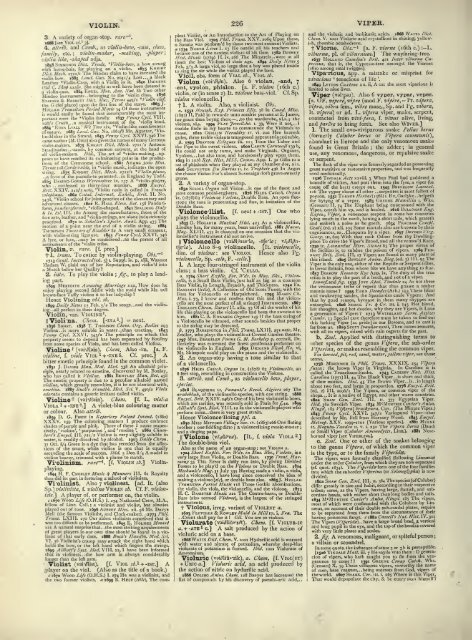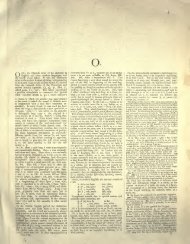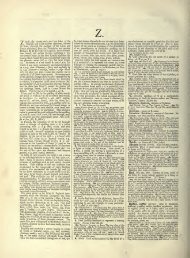You also want an ePaper? Increase the reach of your titles
YUMPU automatically turns print PDFs into web optimized ePapers that Google loves.
VIOLIN.<br />
3. A variety of organ-stop, rarc^,<br />
1688 [see Viol si>.^ 3J.<br />
4. aitrib. and Conth,, as violiit-boio, -case, class<br />
family y etc; violin-maker^ -niakitig^ -player<br />
violin hike, -s/iapeii adjs.<br />
1858 SiMMONDS Diet. Trade^ *yu>lin'bh,<br />
rhombic octahedrons.<br />
t Viorne, Obs.~^ [a. F. viorne (16th c.) :—L.<br />
vllmrna, pi. oi viburnum.'] The wayfaring-tree.<br />
1637 Holland Camden's Brit. 421 inter vibuma Cupnssus,<br />
that is, the Cypresse-lree amongst the Viorncs<br />
[1610 among smal twigges].<br />
Vipa*rlous, app. a mistake or misprint for<br />
vivacious * tenacious of life ',<br />
1849 LvTTON Caxtons XII. ii, .\ cat the most viparious is<br />
limited to nine lives.<br />
Viper (vai'pai). Also 6 vyper, vypar, vepor.<br />
[a. OF. vipere^ vipre (mod.F. vipere,^ Vx. vipera,<br />
vipra, vibra fem., vibre masc.,Sp.and 1'^. vibora^<br />
It. vipera) or ad. L. vipera viper, snake, serpent,<br />
contracted from vlvi-pera, f. vivus alive, living,<br />
and parere to bring forth. See nlso Wiveb.]<br />
1. The small ovo-viviparous snake Felias bents<br />
(formerly Coluber berus or Vipera communis),<br />
abundant in Europe and the only venomous snake<br />
found in Great Britain ; the adder ; in general<br />
use, any venomous, dangerous, or<br />
or serpent.<br />
repulsive snake<br />
The flesh of the viper was formerly regarded as possessing<br />
great nutritive or restorative properties, and was frequently<br />
used medicinally.<br />
1516 TiNDALK Acts xxviiu 3 When Paul had gaddered a<br />
boundle of stickes. And putt thein into the fyre, a viper (be<br />
cause off the heet) creept out. 154S Brinklow Lameut.<br />
116 The vypar aboue all other ..serpentes is most fullest of<br />
poyson. 1551 Turner //*; (^a/( 1 568) i.Bv,Garlyke..helpeth<br />
tlie bytyng of a veper. 1583 Gbef.ne Mamiliia 1. Wks.<br />
(Grosari) II. 74 The Elephant being enuenomed with the<br />
Viper, eateth him vp, and is healed. 1616 Bullokar Eng.<br />
Expos., Viper, a venemous serpent in some hot countries<br />
lying much in the earth, hauingashort taile, which gratetli<br />
and maketh a noise as he goeth. 1634 Pkacham Compl,<br />
Gentl. (ed. 2) xii. 109 Some mortals also are kiiowne by their<br />
cognisances, as. .Cleopatra by a viper. 1697 Dkvden Viig.<br />
Georg. III. 629 With that rank Odour from thy Dwellingplace<br />
To drive the Viper's Brood, and all the venom 'd Race.<br />
1750 tr. Leonardus' Mirr. 67o«cs- 65 The proper virtue of<br />
the Sicilian is, to subdue the poison of vipers. 1769 Pennant<br />
Brit. Zool. III. 17 Vipers are found in many parts of<br />
this island. 1805 Binglev Anim. Biog. (ed. 3) III. 95 The<br />
Viper is the only one, either of the Reptile or Serpent tribes,<br />
in Great Britain, from whose bite we have any thing to fear.<br />
1857 Borrow Romany Rye App. ix. The duty of the true<br />
critic is to play the part of a leech, and not of a viper.<br />
trans/. EiTi^ Jig. 1535 Jove ApoL Tindale 24 .\t not these<br />
the venomouse tethe of vepers that thus gnawe a nother<br />
mannis name? 1555 Kuen Decades {Xrh.) 193 'these blind<br />
and swalowyng sandes, the Spaniardes caule Vypers :<br />
And<br />
that by good reason, bycause in them many shyppes are<br />
entangled. 1606 Shaks. Tr. 4- Cr. iii. i. m^ Hot bloud,<br />
hot thoughts, and hot deedes, why they are Vipers, is Loue<br />
a generation of Vipers? 1713 Waterland Serm. Assizes<br />
Cambr. 13 Special care therefore must be taken to find out<br />
this lurking Viper [sc. piidej in our Bosoms, and to cast it<br />
far from us. 1819 Scorr Ivanhoe xxvii. Then comes remorse,<br />
with all its vipers, mixed with vain regrets for the past.<br />
b, ZooL Applied with distinguishing terms to<br />
other species of the genus Vipera^ the sub-order<br />
Viperina, or snakes resembling the common viper.<br />
For Itomed, pit, red, sand, water, yellow viper, see those<br />
terms.<br />
1736 Mortimer in PhiL Trans. XXXIX. 25^ Vipera<br />
fusca : the brown Viper in Virginia. In Carolina it is<br />
called the Truncheon-Snake. xw Catesbv Nat. Hist.<br />
Carolina (1771) II. 44 The Black Viper . . is short and thick,<br />
of slow motion. Ibid, 45 The Brown Viper, .is. .in length<br />
about two feet, and large in proportion. tj'jZ Encycl. Brit.<br />
(ed. 2) III. 2t^/i The Vipera, or common viper of the<br />
shops. . . It is a native of Egypt, and other warm countries.<br />
180S Shaw Gen, ZooL III. n. 377 Egyptian Viper.<br />
Ibid. 382 Swedish Viper. 1834 M^Muktbie C«2/iVrV^«/wi.<br />
Kingd. 185 Viplera] brachyura, Cuv. (Ihe Minute Viper.)<br />
1843 Penny CycL XXVI. 347/2 Variegated Viper—that<br />
described by Mr. Bell from Hornsey Wood. 1845 Encycl.<br />
Metrop.XA.y. 1099-1101 [Various species]. x86x Hulme<br />
tr. Moguin-Tandon 11. v. i. 250 The Vipera Berus (DaudJ<br />
or Small Viper (Coluber Ammodytes, Linn,). x88x Nosehorned<br />
viper [see Viperling].<br />
C. ZooL One or other of the snakes belonging<br />
to the genus Vipera, of which the common viper<br />
is the type, or to the family Viperidse.<br />
The vipers were formerly classified (following Linnaeus)<br />
under the order Coluber, from which they are now separated<br />
(cf. quot. 1834). The Viperidae form one of the four families<br />
into which the suborder Viperina (or Solenoglypha) is now<br />
divided.<br />
180S Shaw Gen. ZooL HI. ti. 364 The species (of Coluber]<br />
differ greatly in size and habit, according to their respective<br />
tribes; some, as the Vipers, having large, ftattish, and subcordate<br />
heads, with rather short than long bodies and tails.<br />
1834 McMurtrie Cuvier's Anim. Kingd. 185 The vipers,<br />
most of which were confounded with the Colubers by Linnffius,<br />
on account of their double sub-caudal plates, require<br />
to be separated from them from the circumstance of theuhaving<br />
poisonous fangs, c x88a Cassell's Nat. Hist. IV. 311<br />
The Vipers ( Viperida;)..hsiVfi a large broad hea






